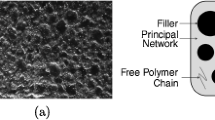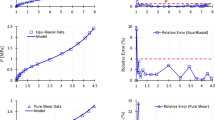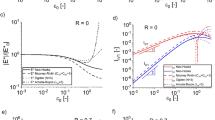Abstract
The Payne effect, the nonlinear mechanical behavior of filled elastomers in oscillatory loading conditions, has received considerable attention in the literature. This is because of the extensive use of these materials in different industrial applications. While experimental investigations of the Payne effect have been comprehensive, the models developed to describe the behavior and predict the response in different loading conditions have not been adequate. Most models fall short of capturing some of the characteristic features of the Payne effect. Those models that do describe all aspects of the Payne effect employ a considerably large number of model parameters. In this study, two different models are developed to describe the Payne effect, using two different approaches. One was developed using a framework of multiple natural configurations. The other was developed using internal variables called structure parameters, like those used to characterize thixotropy of fluids. Both models use a relatively small number of model parameters. However, both models were able to capture to a reasonable extent the different features of the Payne effect. This includes the variation of the apparent storage and loss moduli with strain amplitude and frequency, the lack of effect of static strain offsets on the stress response to the oscillatory part of the strain loading and the nonlinear dependence of the response of the material on the loading history. Both models were found to describe experimental observations of the variation of the apparent storage modulus and the apparent loss modulus with strain amplitude and frequency.








Similar content being viewed by others
References
Anand, M., Rajagopal, K.: A shear-thinning viscoelastic fluid model for describing the flow of blood. Int. J. Cardiovasc. Med. Sci. 4(2), 59–68 (2004)
Barnes, H.: Thixotropy—a review. J. Non-Newtonian Fluid Mech. 70(1–2), 1–33 (1997)
Berg, M.: A non-linear rubber spring model for rail vehicle dynamics analysis. Veh. Syst. Dyn. 30(3–4), 197–212 (1998)
Bergstrom, J.S., Boyce, M.C.: Mechanical behavior of particle filled elastomers. Rubber Chem. Technol. 72(4), 633–656 (1999)
Chazeau, L., Brown, J., Yanyo, L., Sternstein, S.: Modulus recovery kinetics and other insights into the Payne effect for filled elastomers. Polym. Compos. 21(2), 202–222 (2000)
Chen, Y., Li, Z., Wen, S., Yang, Q., Zhang, L., Zhong, C., Liu, L.: Molecular simulation study of role of polymer-particle interactions in the strain-dependent viscoelasticity of elastomers (payne effect). J. Chem. Phys. 141(10), 104901 (2014)
Coveney, V., Johnson, D.: Rate-dependent modeling of a highly filled vulcanizate. Rubber Chem. Technol. 73(4), 565–577 (2000)
Diani, J., Fayolle, B., Gilormini, P.: A review on the Mullins effect. Eur. Polym. J. 45(3), 601–612 (2009)
de Souza, M.P., Rajagopal, K., Thompson, R.: A thermodynamic framework to model thixotropic materials. Int. J. Non-Linear Mech. 55, 48–54 (2013)
Drozdov, A.D., Dorfmann, A.: The payne effect for particle-reinforced elastomers. Polym. Eng. Sci. 42(3), 591–604 (2002)
Fröhlich, J., Niedermeier, W., Luginsland, H.D.: The effect of filler-filler and filler-elastomer interaction on rubber reinforcement. Compos. A Appl. Sci. Manuf. 36(4), 449–460 (2005)
Fuller, K., Ahmadi, H., Coveney, v.: Seismic isolation with high damping rubber bearings: theory and practice. Earthq. Blast Impact 141–150 (1991)
Gauthier, C., Reynaud, E., Vassoille, R., Ladouce-Stelandre, L.: Analysis of the non-linear viscoelastic behaviour of silica filled styrene butadiene rubber. Polymer 45(8), 2761–2771 (2004)
Haupt, P., Lion, A.: On finite linear viscoelasticity of incompressible isotropic materials. Acta Mech. 159(1–4), 87–124 (2002)
Höfer, P., Lion, A.: Modelling of frequency-and amplitude-dependent material properties of filler-reinforced rubber. J. Mech. Phys. Solids 57(3), 500–520 (2009)
Humphrey, J., Rajagopal, K.: A constrained mixture model for growth and remodeling of soft tissues. Math. Models Methods Appl. Sci. 12(03), 407–430 (2002)
Kannan, K., Rao, I., Rajagopal, K.: A thermomechanical framework for the glass transition phenomenon in certain polymers and its application to fiber spinning. J. Rheol. 46(4), 977–999 (2002)
Kraus, G.: Mechanical losses in carbon-black-filled rubbers. J. Appl. Polym. Sci. Appl. Polym. Symp. 39, 75–92 (1984)
Lion, A., Kardelky, C.: The Payne effect in finite viscoelasticity: constitutive modelling based on fractional derivatives and intrinsic time scales. Int. J. Plast. 20(7), 1313–1345 (2004)
Lorenz, H., Klüppel, M.: Microstructure-based modelling of arbitrary deformation histories of filler-reinforced elastomers. J. Mech. Phys. Solids 60(11), 1842–1861 (2012)
Luo, W., Hu, X., Wang, C., Li, Q.: Frequency-and strain-amplitude-dependent dynamical mechanical properties and hysteresis loss of CB-filled vulcanized natural rubber. Int. J. Mech. Sci. 52(2), 168–174 (2010)
Mark, J., Erman, B., Roland, M.: The Science and Technology of Rubber. Academic Press, Cambridge (2013)
Mewis, J.: Thixotropy—a general review. J. Nonnewton. Fluid Mech. 6(1), 1–20 (1979)
Österlöf, R., Wentzel, H., Kari, L.: A finite strain viscoplastic constitutive model for rubber with reinforcing fillers. Int. J. Plast. 87, 1–14 (2016)
Ouyang, G.B.: Modulus, hysteresis and the payne effect: network junction model for carbon black reinforcement. KGK Kautschuk, Gummi, Kunststoffe 59(6), 332–343 (2006)
Palade, L.: An integral constitutive law for viscoelastic fluids based on the concept of evolving natural configurations: stability analysis. Int. J. Non-Linear Mech. 39(8), 1275–1287 (2004)
Palade, L., Walton, J., Farina, A.: A new constitutive equation that models extensional flow strain hardening based on evolving natural configurations: stability analysis. Int. J. Non-Linear Mech. 39(3), 379–387 (2004)
Raghunath, R., Juhre, D., Klüppel, M.: A physically motivated model for filled elastomers including strain rate and amplitude dependency in finite viscoelasticity. Int. J. Plast. 78, 223–241 (2016)
Rajagopal, K.: Multiple natural configurations in continuum mechanics. Tech. Rep. 6, Institute for Computational and Applied Mechanics (1995)
Rajagopal, K., Srinivasa, A.: A thermodynamic frame work for rate type fluid models. J. Nonnewton. Fluid Mech. 88(3), 207–227 (2000)
Rajagopal, K., Srinivasa, A.: On the thermomechanics of materials that have multiple natural configurations. Part ii: Twinning and solid to solid phase transformation. Zeitschrift für angewandte Mathematik und Physik 55(6), 1074–1093 (2004)
Randall, A.M., Robertson, C.G.: Linear-nonlinear dichotomy of the rheological response of particle-filled polymers. J. Appl. Polym. Sci. 131(19), 40818. https://doi.org/10.1002/app.40818
Rao, I., Rajagopal, K.: The status of the K-BKZ model within the framework of materials with multiple natural configurations. J. Nonnewton. Fluid Mech. 141(2–3), 79–84 (2007)
Rendek, M., Lion, A.: Strain induced transient effects of filler reinforced elastomers with respect to the Payne-effect: experiments and constitutive modelling. ZAMM-J. Appl. Math. Mech./Zeitschrift für Angewandte Mathematik und Mechanik: Applied Mathematics and Mechanics 90(5), 436–458 (2010)
Sjöberg, M.M., Kari, L.: Non-linear behavior of a rubber isolator system using fractional derivatives. Veh. Syst. Dyn. 37(3), 217–236 (2002)
Stein, J., Prusa, V.: Viscoelastic rate type fluids with temperature dependent material parameters–stability of the rest state. In: AIP Conference Proceedings, AIP Publishing, vol 1843, p 020004 (2017)
Tarrago, M.G., Kari, L., Vinolas, J., Gil-Negrete, N.: Frequency and amplitude dependence of the axial and radial stiffness of carbon-black filled rubber bushings. Polym. Test. 26(5), 629–638 (2007)
Termonia, Y.: Molecular modeling of particle reinforcement in elastomers: effect of particle radius and volume fraction. Polymer 51(19), 4448–4451 (2010)
Ulmer, J.: Strain dependence of dynamic mechanical properties of carbon black-filled rubber compounds. Rubber Chem. Technol. 69(1), 15–47 (1996)
Vieweg, S., Unger, R., Heinrich, G., Donth, E.: Comparison of dynamic shear properties of styrene-butadiene vulcanizates filled with carbon black or polymeric fillers. J. Appl. Polym. Sci. 73(4), 495–503 (1999)
Wang, X., Robertson, C.: Strain-induced nonlinearity of filled rubbers. Phys. Rev. E 72(3), 031406 (2005)
Xi, H., Hentschke, R.: Dynamic moduli of filled elastomers—a coarse grained computer model. Eur. Polym. J. 48(10), 1777–1786 (2012)
Acknowledgements
The authors thank Professor Laurent Chazeau, MATEIS, INSA-Lyon, for useful talks on the Payne effect. They also gratefully acknowledge INSA-Lyon for financial support.
Author information
Authors and Affiliations
Corresponding author
Additional information
Publisher's Note
Springer Nature remains neutral with regard to jurisdictional claims in published maps and institutional affiliations.
Rights and permissions
About this article
Cite this article
Atul Narayan, S.P., Palade, L.I. Comparison of a natural configuration approach and a structural parameter approach to model the Payne effect. Acta Mech 231, 4781–4802 (2020). https://doi.org/10.1007/s00707-020-02774-9
Received:
Revised:
Published:
Issue Date:
DOI: https://doi.org/10.1007/s00707-020-02774-9




